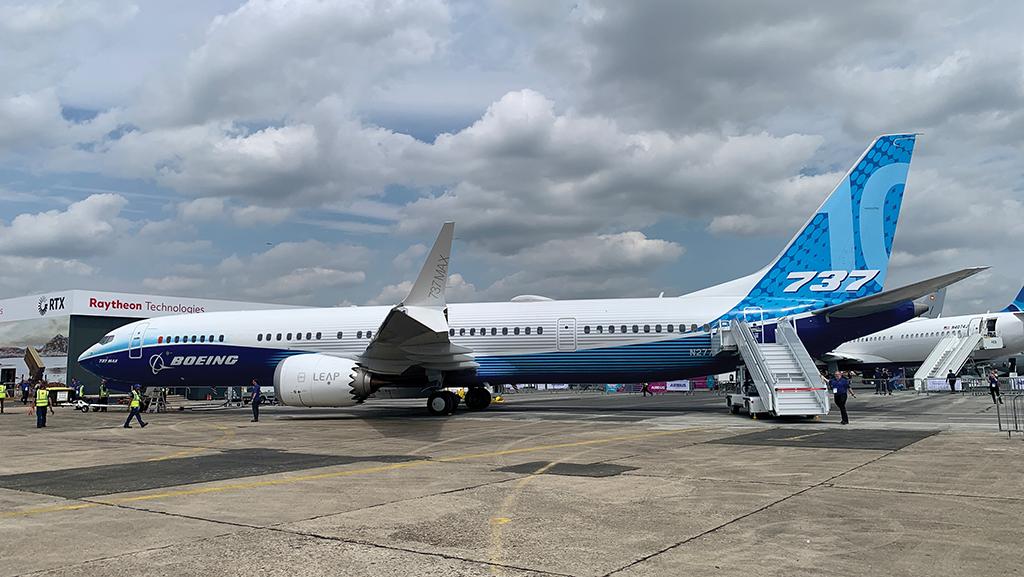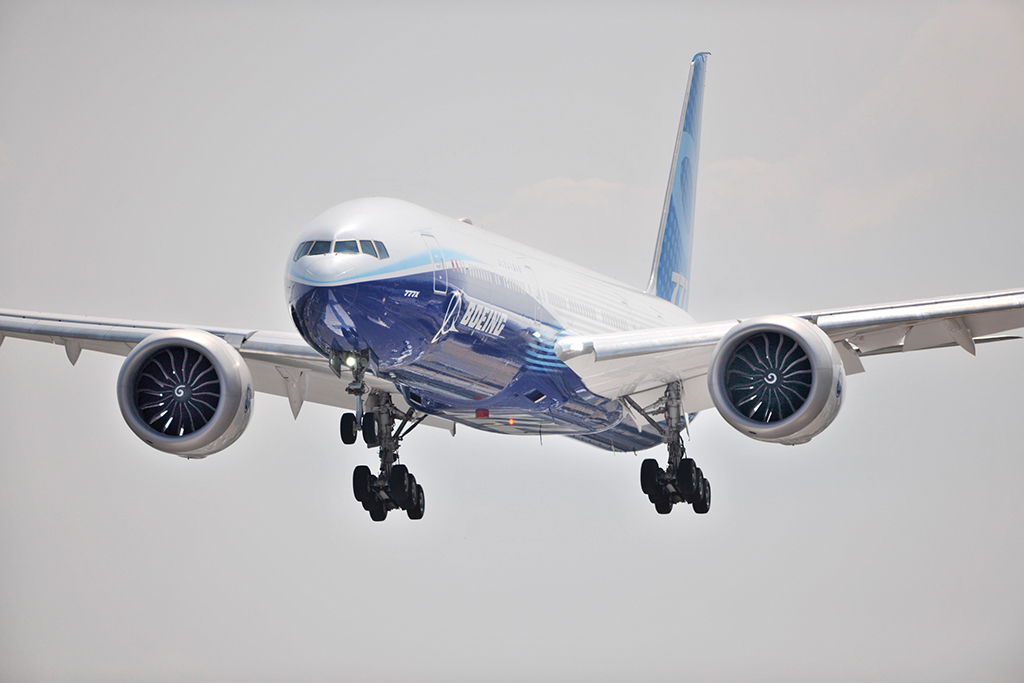
The 737-10 will be the first MAX family member with a synthetic angle-of-attack data source, which will be added to every other in-service and on-order MAX aircraft in the global fleet.
Boeing bolstered its commercial aircraft backlog with a few new orders during the Paris Air Show, but the most encouraging of its developments to emerge at Le Bourget was not backed by a formal announcement: The company is slowly reawakening its dormant 777-9 production process, seemingly making good on its 2022 manufacturing scheduling projection for its next widebody twin.
- Airframer revealed progress on 737-10 and 777-9 certification
- 777-9 production is close to restarting
Several Boeing suppliers confirmed to Aviation Week that they have been asked to begin shipping parts to support restarting 777-9 final assembly, paused since early 2022, in early 2024. When Boeing revealed the stoppage 14 months ago, it said “production” would pause through at least 2023, and certification-related challenges would delay first deliveries of the new-generation widebody twin to 2025 from late 2023 (AW&ST May 2-15, 2022, p. 24). Activating the front end of the production process now aligns with that timeline—Boeing generally equates production with final assembly work, including gathering parts and subassemblies at the first station on the line.
Despite the seemingly positive development, Boeing declined to discuss or even formally acknowledge the move.
“As we have said, we diligently manage all aspects of our production system and would execute a robust plan and phased approach to reintegrate the 777-9 into production,” the company said in a statement.
Boeing remains hesitant to send signals that suggest it is taking anything for granted regarding major certification milestones on any of its programs. Restarting 777-9 supplier shipments points to confidence in the program’s certification progress, which has faced several hurdles in the past two years. The next key milestone, FAA Type Inspection Authorization (TIA), would clear Boeing to begin formal certification test flights.
The company’s current timeline sees certification and first deliveries—once slated for 2019—due to occur in late 2025. It appears to be making progress toward that target.

Boeing has completed responses to questions from the European Union Aviation Safety Agency (EASA) and the FAA over new design aspects of the 777 family, including redundancy in the flight control system. As a result, the OEM says it is poised to begin certification of the aircraft as soon as the U.S. regulator gives the all-clear to start testing.
“We are ready from an airplane standpoint for TIA,” says Justin Hale, Boeing’s 777X customer leader and product marketing director. The three active development aircraft have amassed around 3,000 flight hours and 1,000 cycles in the program, he adds. The fourth is being refurbished with a full interior prior to joining the test campaign this year.
Tests have included validation of components added to address regulators’ concerns about potential common mode failures in the 777X flight control system and “have all been related to qualification of those parts,” Hale says.
Detailed technical exchanges with the FAA are a routine part of any Boeing certification project. But formal queries directly from EASA are rarer, since the European agency’s role under the U.S.-EU safety bilateral is to validate the FAA’s findings. With EASA seemingly satisfied, the process has “got us back to where the bilateral will work between the U.S. and EASA,” Hale notes.
Program delays led Boeing to pause all 777-9 production so the company could focus on assembling in-demand 777F freighters and prevent the buildup of additional 777-9 inventory. There are 24 completed 777-9s and several more in various states of final assembly, the Aviation Week Network Fleet Discovery database shows.
With the possibility of certification tests in the offing and with it a firmer configuration, new production is on track to resume—albeit at a very slow rate. The goal is to support a ramp-up to at least four aircraft per month in 2025. Program sources indicate the initial rate when production restarts could be as low as half an aircraft per month.
The company also revealed that it is getting a head start on retrofitting the 737 MAX fleet with an additional angle-of-attack (AOA) data source safety enhancement package. Plans call for rolling out new aircraft with the needed wiring and preparing a service bulletin for operators to use on in-service airframes.
“All the airplanes we are building now are prewired,” says Bob Michael, 737 customer leader. “We actually started to install the wiring on production [aircraft] last summer.”
The synthetic enhanced angle-of-attack (eAOA) package is being introduced on the 737-10 as part of an EASA requirement related to the agreement for the 737 MAX’s return to service following fatal accidents in 2018 and 2019 as well as its subsequent grounding (AW&ST Aug. 29-Sept. 11, 2022, p. 26). The eAOA package is planned to be added to all MAX aircraft at Boeing’s expense. Its software collects data from five aircraft parameters and constantly cross-checks the derived AOA against inputs from the two standard AOA sensors mounted on either side of the aircraft’s nose. If the eAOA detects an erroneous signal from either of the standard sensor vanes, it is designed to suppress that input.
The package, intended to mitigate risks spotlighted in the aforementioned fatal 737-8 accidents in 2018 and 2019 that prompted regulators to reexamine the MAX flight control system, includes new switches in front of the captain’s (left) seat that allow pilots to disable nuisance alerts triggered by a malfunctioning AOA. While the new eAOA is designed to do this, the switches serve as a backup; the new wiring is for the switches.
“There’s a fair amount of wiring that has to be added in the flight deck and in the [electronic equipment] bay,” Michael says.
Boeing is working on a service bulletin that operators can use to prewire their 737 MAXs. It is expected to be released by year-end. Once the 737-10 is certified, a second service bulletin will detail the entire upgrade. Boeing’s latest 737-10 plan includes FAA approval in 2024, but the timeline is far from certain given the lengthening of the 737-7 and 777-9 programs under increased FAA scrutiny (AW&ST April 24-May 7, p. 50).
The certification program news overshadowed a tame show in terms of fresh Boeing orders. The company booked 224 official new purchases—all but four of them confirmations of a massive Air India deal unveiled earlier this year. Another 56 orders were already in Boeing’s books as having undisclosed customers. Airbus more than tripled Boeing’s haul, with 805 new firm orders.

